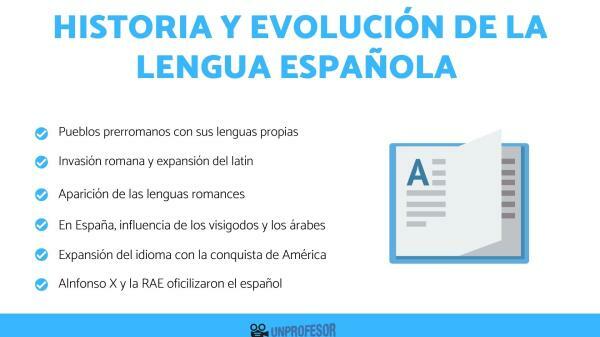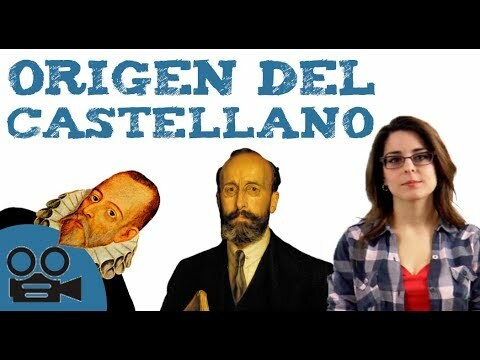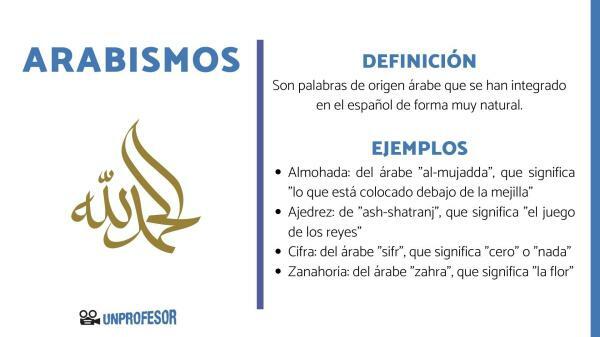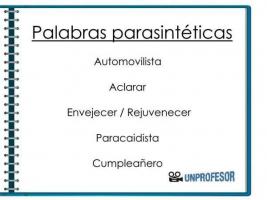History and evolution of the Spanish LANGUAGE

Spanish is a Romance language, that is It comes from the Latin. However, today we also preserve characteristic features of the languages that were spoken in the Iberian Peninsula before the Roman conquest. In addition, many other languages with which we have been in contact throughout history have also influenced the development of Spanish, ever since Castilian began in the Middle Ages.
In this lesson by a PROFESSOR we want to explain to you what has been the history and evolution of the spanish language to this day. Think that languages are alive and undergo changes as societies advance, so how do you think we will speak in 100 years? At the moment we can only look back to see the full picture of our language.
To know the history and evolution of the Spanish language we must know the origin of the language.
The Roman invasion in the Iberian Peninsula It was during the 2nd century BC. c. and what happened before we know it as the pre-roman times. This stage was characterized by the existence of
different towns in the Peninsula and each of them had their own language, not at all similar to what we now know as Spanish. We talk about the Iberians, the Carthaginians, the Celts, the Basques and the Phoenicians.All the languages that coexisted during the pre-Roman era were gradually disappearing with the passage of time, just when the Romans came to our lands. The only language that still survives is Euskera or, or also known as "Basque". However, many of the words used by the pre-Roman inhabitants still exist in Spanish today, such as CABAÑA or PERRO.
When the Romans were already fully installed in the Iberian Peninsula, part of their customs and culture spread throughout the territory and, among them, the Latin language. During this process, Latin and the pre-Roman languages coexisted, until Latin was established as the official language of Spain. The only exception was the Basque Country, as its people put up a strong resistance against the Romans and managed to retain their own language.
This makes most of the Spanish vocabulary we know today comes from Latin.
However, Spanish showed an innovative character with respect to the other Romance languages, due to the fact that the region in which it was formed had not been very romanized. It was an area of men-at-arms and where high culture (which was expressed in Latin) had little presence. So we can find some characteristics that differentiate Spanish from other languages derived from Latin:
- the initial F typical of Latin, which is preserved in other languages, in Spanish it becomes an aspirated H and finally it stopped being pronounced. For example: *farina = flour
- Latin vowels E and O tonic, became diphthongs in Spanish. For example: *ventu = wind, *focu = fire.
- Words starting with groups PL-, CL- and FL- evolved to LL-. For example: *plorare = cry, *clamare = to call, *flama = flame.
- the typical syllable cul from Latin, which was placed after the tonic syllable, ended up deriving into a J. For example: *speculu = mirror
- Finally, the consonant cluster -CT- evolved to become CH. For example: *factu = done, *nocte = night.

roman rule began to have a greater reach throughout Europe and reached countries such as Portugal, France, Romania and Italy. Therefore, the languages in all these countries derive from Latin and are known as Romance languages.
Besides, Latin underwent different evolutions in Spain, due to the different geographical areas that had little contact with each other. This is where the different dialects and co-official languages that exist in Spanish territory, as is the case of Catalan or Galician.
- During the V century AD. C., the Iberian Peninsula was conquered by the visigoths, also known as the barbarian peoples. The new tenants adapted to the language that had been established in the Spanish territory for several centuries, but they managed to add different words that are now typical of our culture.
- Later, at the beginning of the 8th century The Arabs arrived in the Iberian Peninsula and they invaded it practically in its entirety, together with the south of France. This period of time lasted for several centuries. This is the main reason why we currently have many words in our dictionary that come from Arabic. The figure is estimated to be between 5,000 and 10,000 words from this language.
Therefore, the Arabic influence It is very noticeable in Spanish and was a very important part of its evolution towards the language we know today; is what is known as arabisms.

Christians living on the Iberian Peninsula began what is known as The reconquest, starting from the north of the territory and moving south to drive the Arabs out of Spain.
Over the years, Latin slowly and gradually evolves to become what we know as CASTILIAN, the language established in Spain at the end of the 14th century. History indicates that this language was officially born in the northern part of Castile and that's where his name comes from.
The fifteenth century marked a before and after for our language, since in 1492 Christopher Columbus set out on his way to America. When they arrived at what we know today as Latin America, the communication of the Spanish with the natives was practically impossible. For this reason, the Catholic Church decided to establish Spanish in these American nations as well.
The tongue began to spread due to the schools and educational centers that the Catholics inaugurated, so that later generations already used Spanish as the main language in their daily lives.
With the arrival of Spain in America, the language spread throughout a large part of that continent, giving rise to numerous dialects and variants They present differences in terms of pronunciation and vocabulary.
Here we leave you the Summary of the discovery of America.

Starting from the 19th century, Some factors have definitely influenced the leveling of the official language Over the dialects of spanish. This has resulted in improved communications and the implementation of compulsory school. This leveling took place at the beginning of the 20th century due to the appearance of radio and, later, television.
In a certain way, the traditional rural speeches disappeared cause of the waves of emigration from the countryside to the cities that have been recurrent in recent centuries. This has caused a traditional type of life to be abandoned and with it a type of vocabulary, forgetting words that characterized it such as THRESHING, LINING, BALIDA, etc. For many people these words already sound old-fashioned or even unrecognizable.
How many people speak Spanish today?
Currently, there are approximately 534 million Spanish speakers, most of them concentrated in Spain and Latin America. This means that Spanish has become the fourth most spoken language in the world and the second language of international communication.
Spanish is officially spoken in 21 countries: Spain, Mexico, Guatemala, El Salvador, Honduras, Nicaragua, Costa Rica, Panama, Colombia, Ecuador, Peru, Bolivia, Chile, Argentina, Uruguay, Paraguay, Venezuela, Puerto Rico, Dominican Republic, Cuba and Guinea Equatorial. However, there are other countries that use it unofficially.
In AndorraFor example, the official language is Catalan, but 93% of the population also speaks Spanish. In Latin America there are also some examples such as Aruba, where the official language is Dutch, but 80% of people communicate in Spanish. In the Netherlands Antilles We also found 59% of people who speak Spanish and in belize the figure rises to 52%.
In the Guam Island, Located in the Pacific Ocean and recently incorporated into the United States, 36% of the population communicates in Spanish. In addition, 18% of the inhabitants of the USA He speaks Spanish, according to data from the Cervantes Institute.
We cannot forget other nations that use Spanish to communicate, even though this language is not the official language in the country: Brazil, Algeria, Morocco, Trinidad and Tobago, Australia, Canada, Virgin Islands (US), Gibraltar, Norway, Switzerland, Angola, Sudan, Western Sahara, south etc In all these countries there Spanish-speaking communities that continue to extend the borders of our language.
Here you have the countries where Spanish is spoken.
Alfonso X it was the king who promoted Castilian as a language from 1200. He was the one who promoted original works to be written in this language at his court and many others translated from Latin, which was a very important advance for the spread of the language.
Another key moment in consolidating Spanish as an official language was the conquest of grenada by the Catholic kings. This event occurred simultaneously with the discovery of America and is the moment in which it appeared Grammar, a work by Antonio Nebrija that was the first treatise that studied the grammar of a European language.

The printing allowed the exact reproduction of texts, which helped to reserve the Spanish language in its written form. Printed books guaranteed that the text was reliable and much more accurate when it came to transmitting the language, compared to the manuscript work in which dozens of errors were recorded.
In addition, the printing press allowed educational materials to be mass-produced, to facilitate access to reading and learning of Spanish, by many more people in society. Therefore, the town became literate and Spanish spread through the streets.
This tool was also crucial when it came to spreading Spanish beyond the borders of Spain. Printed books could be transport and trade which facilitated its distribution in the Spanish colonies and other territories where Spanish was established as the official language. This made it possible for Spanish to consolidate in Latin America and other parts of the world.
The printing press also played a fundamental role in the standardization of the Spanish language. As books were mass-produced, rules and standards of spelling, grammar, and vocabulary were required for the texts to be understood by all readers.
The Royal Spanish Academy (RAE) is an organization dedicated to developing the normative rules of the Spanish language and working for the unity of this language in all the territories where it is spoken. These standards can be seen reflected in the Spanish dictionary and collect both the grammar and the spelling of the language. The purpose of this dictionary is to guarantee that Spanish is always governed by a common linguistic norm.
This cultural institution was founded in 1713 by a group of enlightened people led by Juan Manuel Fernández Pacheco. From them came the idea of creating an academy dedicated to working at the service of the national language. Its current headquarters are in Madrid, but it has affiliations with the national academies of the 21 Spanish-speaking countries. All of them together form the Association of Academies of the Spanish Language.
Now you know a little better history and evolution of the spanish language, so you can understand where the language we use every day comes from. If you want to continue learning more about this topic, do not hesitate to consult our Spanish language lessons, where we will help you understand this language in a deeper way.

